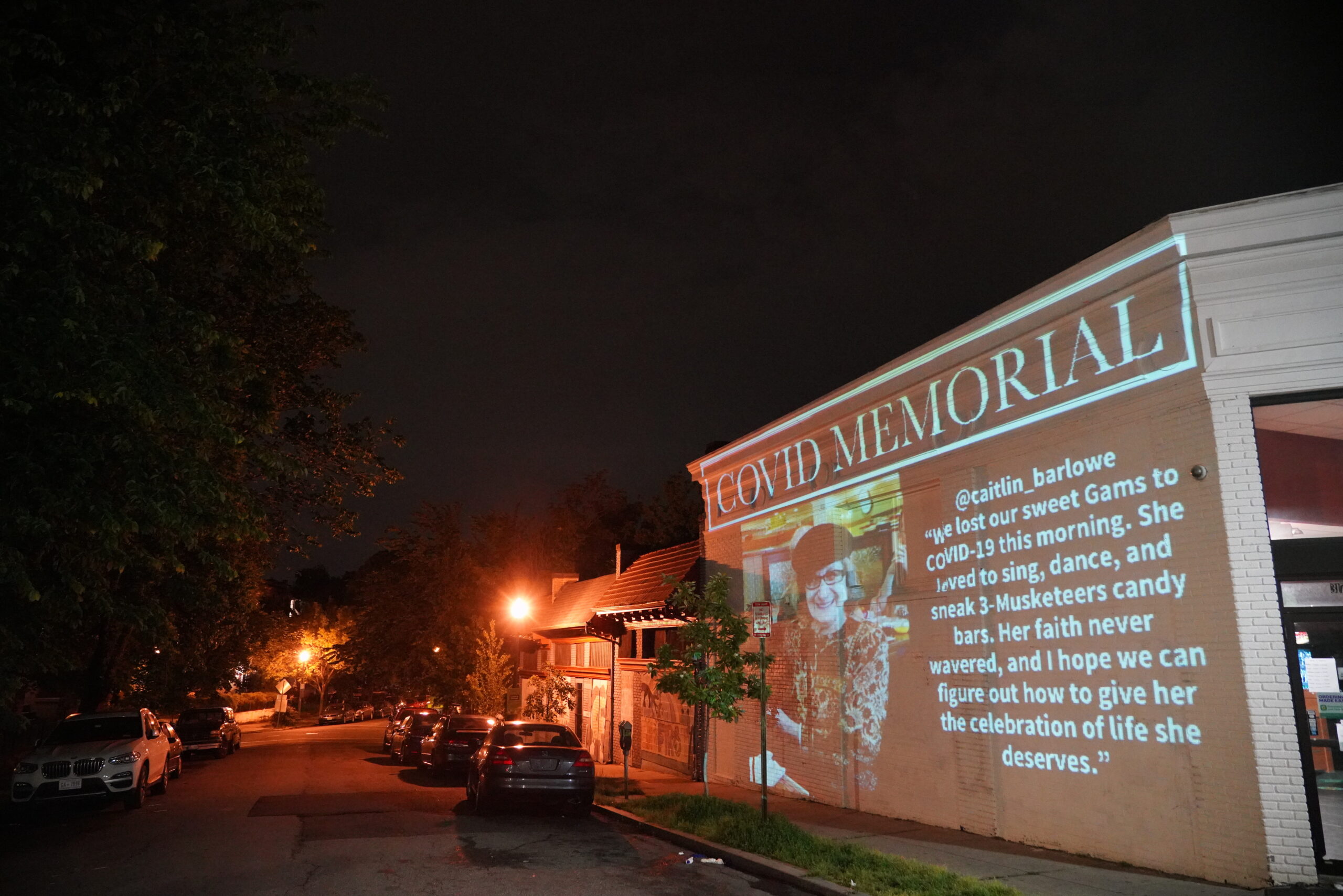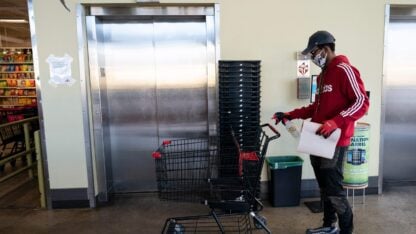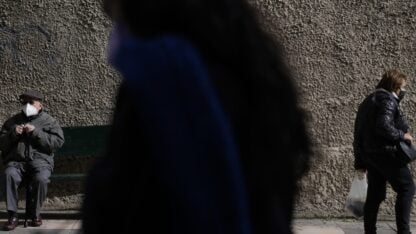In a recent 24-hour virtual vigil streamed live on Facebook, volunteers read out thousands of names, in an excruciating litany of loss.
Naming the dead has become a familiar ritual in other national tragedies, a recitation usually voiced in large, cathartic public gatherings.
This time, the names were read by people sitting alone, in kitchens and bedrooms, looking into a webcam.
A tree of loss
On a walnut farm in Ballard, Calif., Anne Guynn has created her own personal memorial. Each week, she goes out into her family’s orchard, climbs a ladder into one of the walnut trees and hangs garlands of colorful paper hearts she has cut out and strung: one heart for each of the nearly 4,000 Californians who have died from COVID-19.
“It looks like a weeping willow a little bit with all of these dangling hearts, and that’s appropriate to me,” Guynn says. “I’m really very committed to doing this, and I know we probably have a year or more; who knows how long we’re going?”
For those not directly touched by the virus, Guynn says, “it’s easy to feel like it’s not really happening, or to disconnect from it. This is a way to say, ‘No, it’s happening.’ And each heart is not just one person, but a whole family connected to that one person who is gone.”
Guynn and her family have set up a bench under the festooned walnut tree so that people driving by can stop, sit and reflect.
“The wind has blown a lot of the hearts off, so they’re scattered throughout the orchard, and I’ll find little colored hearts everywhere,” she says. “We’ll be harvesting for years to come, and we’ll see hearts come through our harvesting plant, which will be a reminder of what we’ve all been through.”
An urban memorial
On a recent Friday night in what would typically be, pre-COVID, a bustling neighborhood in Washington, D.C., video artist Robin Bell fired up a projector, sending a beam of light out of his apartment window.
Projected onto the brick wall of a Subway sandwich shop across the street appeared the words “Covid Memorial.”
Below them scrolled a slideshow of faces of COVID-19 victims, along with messages their loved ones had posted on social media — messages mourning the loss of their Uncle Rudy, or Auntie Joyce, or cousin Jorel, whose smiling faces flashed into the night, and vanished.
Those walking by, like neighborhood residents Sean Powers and Jina Kang, looked up and slowed down to take in the sight.
“There’s a whole lot of tragedy that gets blended in the digital platform,” Powers said, “and to see this going in your physical space is just a great reminder of the tragedy that we’re living in.”
“I’m seeing COVID-related news all day, which is very depressing,” Kang said. “But in a way, seeing this feels like there’s a community of support in this neighborhood.”
That was the hope of the Covid Memorial’s creator, Duncan Meisel, who launched the project out of his bedroom in Austin, Texas. It began as a digital archive of remembrances, and then expanded to include public video projections.
“There’s something powerful about sharing those stories in public, off the Internet, that lends them a little more concreteness than just another post,” Meisel says. “Y’know, we’re drowning in posts right now.”
We’re drowning in numbers, too, he points out, constantly bombarded with coronavirus statistics, charts, graphs and exhortations to “flatten the curve.”
Meisel hopes projects like his will reinforce our human connections, and remind us to take the steps needed to keep people safe. “I think it’s harder to protect each other when we don’t have a shared sense of what we’ve lost,” he says.
In this time of stay-at-home orders and social distancing, our traditions of collective mourning have been upended. We are left to grieve and process loss largely on our own.
“In any other major national crisis, we would have a chance to mourn together,” Meisel says. “Whether it’s been a mass shooting or a terrorist attack, people can get together, they can lay flowers, they can light candles.”
But now, he says, “we can’t be together, and families who are losing people, they can’t be together either, with their loved ones. I think that it really creates a deeper sense of trauma and loss, and people are searching for ways to make sense of what is an extremely traumatic event.”
When Normina Nicotra of Jersey City, N.J., heard about Meisel’s project, she submitted a tribute to her mother, Amihilda Menina: a registered nurse for more than 50 years who died of COVID-19 at age 76.
“I want so much for people to remember that she’s not just a number,” Nicotra says, “that she was actually important to so many people.”
Nicotra worries that with so much attention focused on the latest coronavirus data, people may lose sight of the individual human toll. “It’s just becoming a number for a lot of people,” she says, “especially as people are sitting at home getting restless, and are so anxious for the economy to open back up again.”
Now, as the U.S. death toll approaches 100,000, Nicotra can’t stop thinking: What if we had responded sooner? What if the country had sheltered in place right away?
“I think about all those unnecessary deaths, and all the families that didn’t get to say goodbye to their loved ones, and I think it’s a failure,” Nicotra says. “I think it’s a hundred thousand completely preventable deaths.”
Copyright 2020 NPR. To see more, visit https://www.npr.org.
9(MDAxODM0MDY4MDEyMTY4NDA3MzI3YjkzMw004))

9(MDAxODM0MDY4MDEyMTY4NDA3MzI3YjkzMw004))








